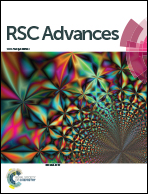Revival, enhancement and tuning of fluorescence from Coumarin 6: combination of host–guest chemistry, viscosity and collisional quenching†
Abstract
Fluorescence from Coumarin 6 (C6), a laser dye, decreases considerably due to microcrystal formation in aqueous environments. The fluorescence yield can be effectively enhanced by applying β-cyclodextrin that revives the molecular entity of C6 through host–guest chemistry. C6-β-CD capsules form nanocubes in solution with surface projected hydroxyl groups. Increase in solvent viscosity brings the nanocubes closer following agglomeration, while keeping the molecular entity of C6 intact. This enhances the fluorescence from C6 encapsulated in β-CD nanocubes by 40%. Moreover, this emission can be tuned quantitatively by applying nanoparticles (silver in the present case) at each environmental viscosity level.


 Please wait while we load your content...
Please wait while we load your content...